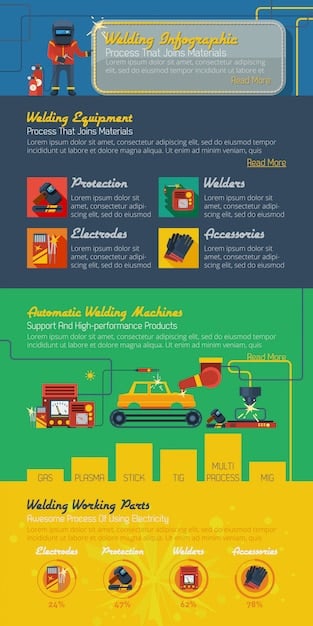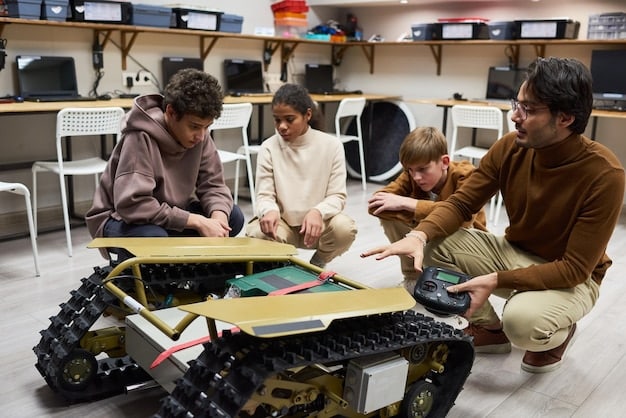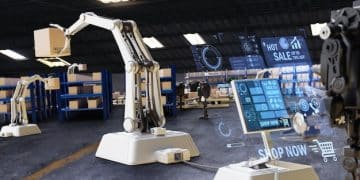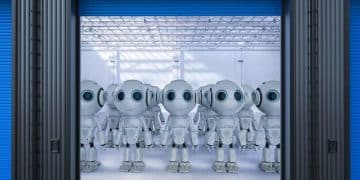Future-Proofing the US Workforce: Skills for Automation Age

Future-proofing your US workforce requires a strategic focus on developing essential skills such as adaptability, critical thinking, technical literacy, and emotional intelligence to navigate the evolving landscape of automation and ensure long-term employability.
The rise of automation is transforming the US job market, creating both challenges and opportunities for American workers. Future-proofing your US workforce: Essential skills for the age of automation is no longer a question of “if,” but “how.” This article will explore the critical skills needed for American workers to not only survive but thrive in this new era.
Understanding the Automation Revolution in the US
Automation is rapidly reshaping industries across the United States, impacting everything from manufacturing and logistics to customer service and finance. Understanding the scope and pace of this change is the first step toward preparing your workforce for the future. What exactly does automation mean for the American worker?
The Current State of Automation in the US
Automation isn’t just about robots replacing human workers; it encompasses a wide range of technologies, including artificial intelligence (AI), machine learning, robotic process automation (RPA), and advanced analytics. These technologies are being deployed to improve efficiency, reduce costs, and enhance productivity across various sectors.
Impact on Different Sectors
The impact of automation varies significantly across different sectors in the US. While some industries face significant job displacement, others see the creation of new roles and opportunities that require different skill sets. For example:
- Manufacturing: Automation is increasing efficiency and reducing labor costs, but it also requires workers with skills in robotics maintenance and programming.
- Healthcare: AI is being used for diagnostics and personalized medicine, creating demand for professionals who can interpret and utilize this data.
- Finance: RPA is automating repetitive tasks, freeing up financial professionals to focus on more strategic and analytical activities.

Understanding these sectoral differences is crucial for tailoring training programs and workforce development initiatives to meet specific needs.
In conclusion, the automation revolution is a complex and multifaceted phenomenon. To effectively prepare the US workforce, businesses and policymakers need to grasp the nuances of its impact across different sectors and proactively invest in developing the skills required to navigate this evolving landscape.
Essential Skills for the Automated Workplace
As automation continues to advance, certain skills become invaluable for American workers. These essential skills fall into several categories, from technical proficiencies to uniquely human traits. What are the core competencies that will future-proof careers in the US?
Technical Skills
While not everyone needs to become a programmer, a basic understanding of technology is essential. This includes data literacy, digital fluency, and skills in areas like cloud computing and cybersecurity. These skills enable workers to understand and interact effectively with automated systems.
Soft Skills
Emotional intelligence, critical thinking, and creativity are increasingly important in a world where machines handle routine tasks. These soft skills allow workers to adapt to change, solve complex problems, and innovate in ways that machines cannot. Consider the following:
- Emotional Intelligence: Understanding and managing emotions, building relationships, and collaborating effectively are crucial for teamwork and leadership.
- Critical Thinking: Analyzing information, evaluating arguments, and making sound judgments are essential for problem-solving and decision-making.
- Creativity: Generating new ideas, developing innovative solutions, and adapting to changing circumstances are vital for staying competitive.
These skills are not only valuable for individual workers but also contribute to a more resilient and adaptable workforce as a whole.
Adaptability and Lifelong Learning
The ability to learn new skills and adapt to changing circumstances is perhaps the most important skill of all. The pace of technological change means that workers must be willing to continuously update their knowledge and abilities throughout their careers. This requires a commitment to lifelong learning and a growth mindset.
In summary, possessing a combination of technical skills, soft skills, and adaptability is crucial for workers to thrive in the automated workplace. By investing in these areas, individuals and organizations can ensure that the US workforce remains competitive and resilient in the face of technological change.
Strategies for Upskilling and Reskilling the US Workforce
To prepare the US workforce for the age of automation, proactive strategies for upskilling and reskilling are essential. These strategies involve a collaborative effort from businesses, educational institutions, and government agencies. How can we effectively equip American workers with the skills they need?
Company-Led Training Programs
Businesses should invest in training programs that provide employees with the skills they need to work alongside automated systems. These programs can range from basic digital literacy training to advanced courses in data analytics and AI. Creating a culture of continuous learning within the workplace is critical.
Partnerships with Educational Institutions
Collaboration between businesses and educational institutions can ensure that training programs are aligned with industry needs. Community colleges, universities, and vocational schools can play a key role in delivering relevant and accessible training to workers. This might involve:
- Developing new curricula that incorporates automation-related skills.
- Offering online and hybrid learning options to accommodate different schedules and learning styles.
- Providing internships and apprenticeships that give workers hands-on experience with new technologies.
These partnerships can help bridge the skills gap and create a pipeline of qualified workers for the future.
Government Initiatives and Funding
Government agencies can support upskilling and reskilling efforts through funding, tax incentives, and workforce development programs. These initiatives can help individuals access training opportunities, particularly those who may not have the resources to do so on their own.

In conclusion, a multi-pronged approach involving company-led training, partnerships with educational institutions, and government initiatives is necessary to effectively upskill and reskill the US workforce. By working together, these stakeholders can ensure that American workers are well-prepared for the opportunities and challenges of the automated workplace.
The Role of Education in Preparing Future Generations
Education plays a crucial role in preparing future generations for the automated workplace. By incorporating relevant skills and knowledge into the curriculum, educational institutions can equip students with the foundation they need to succeed. What should the focus be in educating tomorrow’s workforce?
STEM Education
Science, technology, engineering, and mathematics (STEM) education is essential for developing the technical skills needed in the automated workplace. However, it’s not just about teaching technical skills in isolation; it’s also about fostering critical thinking, problem-solving, and creativity. Educators can:
- Integrate real-world examples and hands-on projects into the curriculum.
- Encourage collaboration and teamwork.
- Promote a growth mindset and a love of learning.
By focusing on both technical skills and essential soft skills, STEM education can prepare students for a wide range of careers in the automated workplace.
Integrating Technology into the Curriculum
Schools should integrate technology into the curriculum in a meaningful way, not just as a tool for delivering instruction but also as a subject of study. Students should learn about the ethical implications of technology, as well as how to use it effectively and responsibly.
Focus on Soft Skills Development
In addition to technical skills, education should also focus on developing soft skills such as communication, collaboration, and critical thinking. These skills are essential for success in any career, but they are particularly important in the automated workplace, where human interaction and collaboration are crucial.
In summary, education has a vital role to play in preparing future generations for the automated workplace. By focusing on STEM education, integrating technology into the curriculum, and prioritizing soft skills development, schools can equip students with the skills and knowledge they need to thrive in the future of work.
Addressing the Challenges and Concerns
While automation offers many benefits, it also raises legitimate concerns about job displacement and economic inequality. Addressing these challenges is essential for ensuring a just and equitable transition to the automated workplace. What are the key challenges and how can we mitigate them?
Job Displacement and the Need for Safety Nets
One of the biggest concerns about automation is the potential for job displacement. While some jobs will be eliminated, others will be created, and many existing jobs will be transformed. To address this challenge, policymakers should consider implementing safety nets such as:
- Expanded unemployment benefits.
- Universal basic income.
- Job retraining programs.
These safety nets can provide a cushion for workers who lose their jobs due to automation and help them transition to new careers.
Economic Inequality and Access to Opportunities
Automation has the potential to exacerbate economic inequality if the benefits are not shared equitably. To address this challenge, policymakers and businesses should work together to ensure that everyone has access to the opportunities created by automation. This includes:
- Investing in education and training programs that are accessible to all.
- Promoting inclusive hiring practices.
- Creating policies that support worker empowerment and collective bargaining.
By ensuring that everyone has a fair chance to succeed in the automated workplace, we can create a more just and equitable society.
Ethical Considerations of AI and Automation
As AI and automation become more prevalent, it’s important to consider the ethical implications of these technologies. This includes issues such as bias in algorithms, data privacy, and the potential for misuse. By addressing these ethical concerns proactively, we can ensure that AI and automation are used in a way that benefits society as a whole.
In conclusion, addressing the challenges and concerns associated with automation is crucial for ensuring a just and equitable transition to the automated workplace. By implementing safety nets, promoting economic equality, and considering the ethical implications of AI and automation, we can create a future where everyone benefits from technological progress.
The Future of Work in the US: A Vision for 2030
Looking ahead to 2030, the future of work in the US is likely to be characterized by increased automation, greater flexibility, and a greater emphasis on lifelong learning. What might the workplace of the future look like, and how can we prepare for it?
The Rise of Remote Work and the Gig Economy
Remote work and the gig economy are likely to become even more prevalent in the future. This will require workers to be adaptable, self-motivated, and skilled in using technology to communicate and collaborate effectively.
The Blurring of Lines Between Work and Life
As technology makes it easier to work from anywhere at any time, the lines between work and life are likely to become increasingly blurred. This will require workers to be mindful of their work-life balance and to set boundaries to protect their well-being.
The Importance of Human Connection
In a world where machines handle many routine tasks, human connection will become even more important. Workers will need to be skilled in building relationships, collaborating effectively, and providing emotional support to their colleagues.
In summary, the future of work in the US is likely to be characterized by increased automation, greater flexibility, and a greater emphasis on lifelong learning. By focusing on developing essential skills, addressing the challenges and concerns associated with automation, and embracing a vision for the future, we can ensure that the US workforce is well-prepared for the opportunities and challenges that lie ahead.
| Key Point | Brief Description |
|---|---|
| 🤖 Automation Impact | Automation is reshaping industries, requiring new skills for the US workforce. |
| 📚 Essential Skills | Technical skills, soft skills, and adaptability are crucial for future jobs. |
| 📈 Upskilling Strategies | Company training, education partnerships, and government support are vital for skill development. |
| 🎓 Education’s Role | Education must focus on STEM, technology integration, and soft skills for future generations. |
FAQ
▼
Future-proofing the workforce refers to proactively preparing workers with the skills and knowledge they need to remain relevant and competitive in a rapidly changing job market, particularly in the face of automation and technological advancements.
▼
Upskilling is vital because it enables US workers to acquire new skills and enhance existing ones, ensuring they can adapt to evolving job roles and demands in an increasingly automated economy, improving job security and career prospects.
▼
Companies play a significant role by providing training programs and resources for their employees to learn new skills necessary for new roles, helping to manage internal transitions and ensuring the workforce remains competitive and adaptable, benefiting both the employees and the organization.
▼
Automation can lead to job displacement in some sectors but also creates new job opportunities requiring different skill sets. Workers who proactively develop adaptable and in-demand skills are more likely to maintain job security in an automated environment.
▼
Key soft skills include critical thinking, problem-solving, creativity, emotional intelligence, and communication. These skills are essential because they complement technological advancements, enabling workers to perform tasks that require human judgment, innovation, and interpersonal interaction.
Conclusion
Future-proofing your US workforce: Essential skills for the age of automation is an ongoing process that requires a collaborative effort from businesses, educational institutions, and government agencies. By investing in upskilling, reskilling, and education, we can ensure that American workers are well-prepared for the opportunities and challenges of the automated workplace, creating a more prosperous and equitable future for all.





